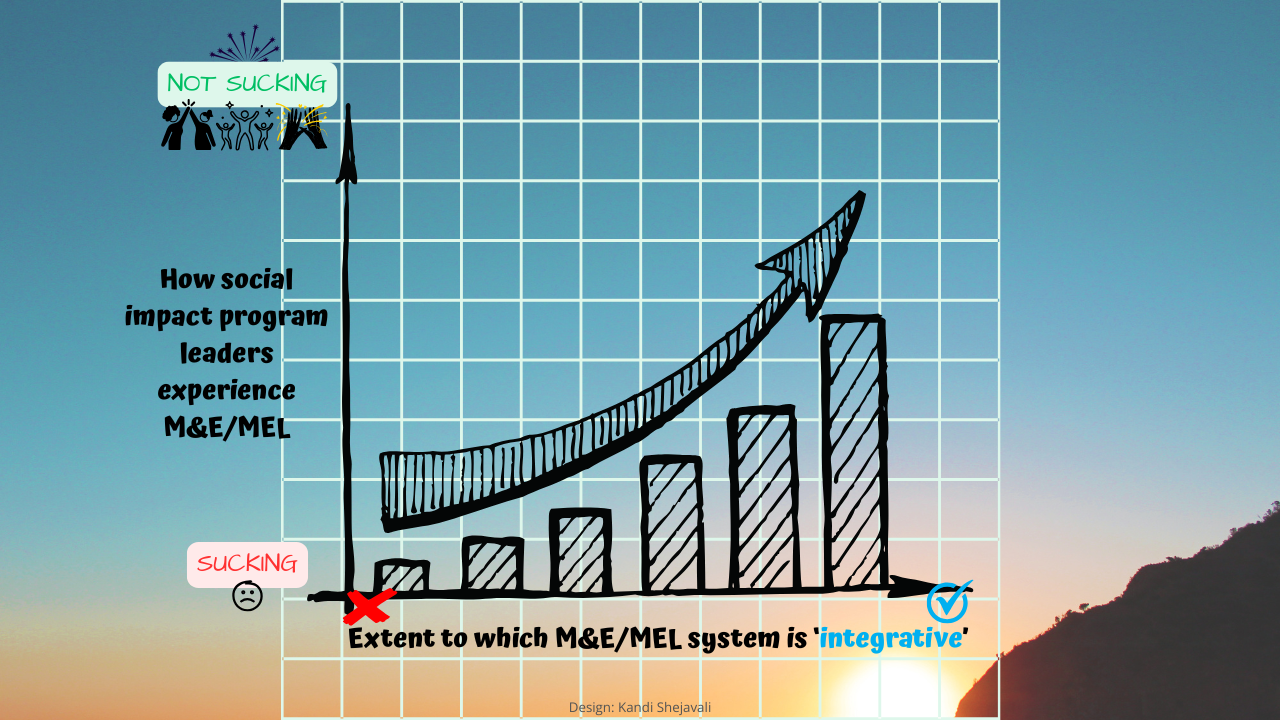Mirror, mirror, on the wall: 3 ways an M&E system can mirror its project (and why it should!)
Nov 22, 2021
Why mirror M&E to the project?
Have you ever heard the saying that a monitoring and evaluation (M&E) system that mirrors the project it serves has a greater likelihood of being user-friendly and effective?
Well, actually, neither have I.
But in my experience, it’s true. An M&E system is much more likely to be successful – in other words, to relatively painlessly produce the most important information to those who need it, when they need it – when the system mirrors the project well.
Here are 3 ways in which that mirroring can be done.
Way 1 of 3: Mirroring via the ToC
I’ve said it before, and I’ll say it again: a project’s theory of change (ToC) should be at the core of that same project’s monitoring and evaluation system. Building an M&E system around the project’s pathway to change – which is what the ToC is, essentially – is fundamental.
Why?
Because the ToC tells us what a project will do in order to produce certain outputs that are, in turn, meant to lead to certain outcomes that, ultimately, contribute to the desired impacts. Given that an M&E system is supposed to measure and assess the extent to which a project’s objectives are achieved, it is logical that it should measure and assess the factors reflecting and influencing the achievement of those objectives.
The ToC thus unifies components of the project and its results measurement system in a perfect mirror image, going a very long way towards assuring the relevance, and thus the effectiveness, of the M&E system.
(Honestly, the ToC has got to be my favorite tool in the M&E toolbox!)
Way 2 of 3: Mirroring the nature of the project
Another way in which the M&E system should mirror the project is in terms of the nature of the project, which is a close cousin – perhaps even twin sibling – to the ToC.
In this context, take “nature of the project” to mean its personality, so to speak. It characterizes the project’s approach, how its set of interrelated activities are undertaken and interact, what those activities consist of, and what kind of change they aim to bring about. An M&E system that mirrors the nature of the project is more likely to not only measure the right things but also measure them right.
A couple examples may help illustrate.
Example 1: If a project is flexible in terms of the specific activities undertaken to achieve project objectives, then the M&E system should mirror that same kind of flexibility in its set-up and, rather than adopting indicators that reflect fixed activities, select indicators that reflect a typology of possible activities. Such an approach is also useful in the case of a common program implementing projects across multiple settings and/or in various contexts as it systemizes measurement while allowing for setting- and/or context-specificity.
Example 2: If a significant portion of a project’s activities consists of efforts that, taken together, could be characterized as, let’s say, advocacy efforts, then the M&E system should mirror this measuring the types of changes that advocacy projects seek to bring about. In this case, it means measuring changes in the project’s target audiences’ level of awareness, willingness to act, and actions taken.
(Sometimes it is surprisingly easy to overlook the essential nature of a project’s core activities, but taking the simple step of characterizing those activities helps provide a richer context for the results measurement system and enhances its relevance. This underscores the importance of having a robust ToC in place… it all comes back to the ToC, my favorite.)
Way 3 of 3: Mirroring the project’s operations
An M&E system should also mirror the project administratively. That means that the M&E system should, to the greatest extent possible, make use of the project’s operational systems, thus making M&E seamless (read: user-friendly).
Take, for example, a project aimed at supporting farmers sustainably increase their incomes. The project uses an intake form to record the details of the farmers participating in the project.
Let’s say that during a revision of the project’s M&E system, a new indicator is added that requires the gathering of information on the number of people benefitting from the project both directly and indirectly, with the farmers being considered to benefit directly while the members of their household benefit indirectly.
To count the number of household members, rather than undertaking a household survey or issuing the farmers a special questionnaire, the relevant question (along with any necessary guidance) could simply be added to the existing farmer intake form. No fuss, no muss.
(I tried to include a reference to the ToC into this third way of mirroring the M&E system to the project, but I couldn’t do so without it seeming like an obvious ploy to mention my favorite M&E tool yet again. Sigh. But wait! In making this note, I got the mention in! Whoop, whoop!)
Over to you!
PRACTICAL TIP #1: Consider your project’s M&E system and assess the extent to which it mirrors the project, whether in the three ways outlined in this article or in other ways. What is your take? Does it do so adequately? How is this affecting the success of the M&E system?
PRACTICAL TIP #2: Jot down two or three actions that can be taken in the short- to medium-term to align the M&E system better with the project – and then take those actions.
PRACTICAL TIP #3: During your project’s next reporting period, assess the extent to which the actions have enhanced the effectiveness and ease of the M&E system (hint: ask your project team members for their opinion). Then consider further ways in which the M&E system could be adapted to mirror the project better and thus be more effective.
Please share your experience by commenting or leaving an emoticon reaction at the bottom of this LinkedIn post.
(Main blog post image credit: Luis Villasmil on Unsplash)





